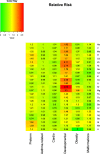Maternal metal concentration during gestation and pediatric morbidity in children: an exploratory analysis
- PMID: 33765932
- PMCID: PMC7995788
- DOI: 10.1186/s12199-021-00963-z
Maternal metal concentration during gestation and pediatric morbidity in children: an exploratory analysis
Abstract
Background: The majority of studies linking exposure to metals with certain health outcomes focus on known toxic metals. Alternatively, this study assesses the extent to which exposure to a wider range of metals during gestation is associated with childhood morbidity.
Methods: We analyzed the concentrations of 25 metals found in urine samples of 111 pregnant women of Arab-Bedouin origin collected prior to birth. In addition, we collected medical records on their offspring for six years following birth, including every interaction with HMOs, local hospitals, and pharmacies.
Results: The main types of morbidities diagnosed and treated during this period were preterm births, malformations, asthma-like morbidity, cardiovascular and behavioral problems, and obesity. Multivariable analysis showed that offspring born before term were more likely to have been exposed to elevated maternal concentrations of zinc, thallium, aluminum, manganese, and uranium, all with adjusted relative risk above 1.40 for an increase by each quintile. Likewise, children with asthma had been exposed to higher levels of magnesium, strontium, and barium at gestation, while behavioral outcomes were associated with elevated biometals, i.e., sodium, magnesium, calcium, selenium, and zinc, as well as higher levels of lithium, cobalt, nickel, strontium, cadmium, vanadium, arsenic, and molybdenum. A heatmap of adjusted relative risk estimates indicates the considerable implications that exposure to metals may have for preterm birth and developmental outcomes.
Conclusions: The current study shows that perinatal exposure to metals is adversely associated with pediatric morbidity. Further such analyses on additional samples are warranted.
Keywords: Cohort; Exploratory Analysis; Heavy metals; Morbidity; Pediatric; Pregnancy.
Conflict of interest statement
The authors declare no that they have no competing interest.
Figures

References
-
- Arruda MAZ. Metallomics: the sience of biometals. Sao Paolo: Springer; 2018.
MeSH terms
Substances
Grants and funding
LinkOut - more resources
Full Text Sources
Other Literature Sources
Medical
